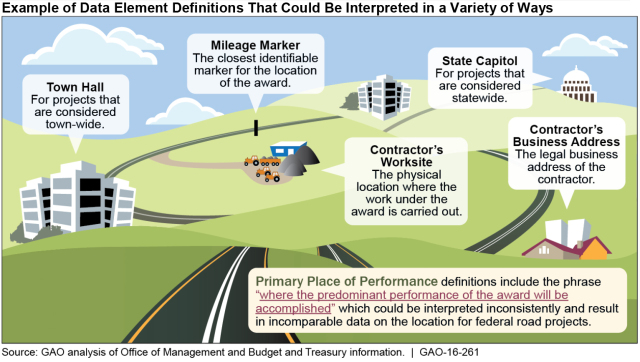The DATA Act Turns 2
 (Excerpted from GAO-16-261)
Changing guidance
Guidance on the definitions can help agencies with their reporting—if that guidance is clear and timely. Treasury has issued several versions of the technical guidance, but each iteration results in revisions that delay a final version and may delay full implementation of the act.
We found that agencies identified changing guidance, along with competing priorities and a lack of resources, as significant challenges to reporting federal spending data as required by May 2017.
Reducing reporting burden
In addition to making it easier to get reliable information on federal spending, the DATA Act also aimed to reduce the reporting burden for those who receive federal dollars. OMB partnered with the Department of Health and Human Services and the General Services Administration to implement a 2-year pilot focused on reducing reporting burden for grantees and contractors.
For more on our DATA Act findings, read our recent testimony or watch it below (our statement starts at 52:48), and check out our recommendations to address DATA Act challenges.
(Excerpted from GAO-16-261)
Changing guidance
Guidance on the definitions can help agencies with their reporting—if that guidance is clear and timely. Treasury has issued several versions of the technical guidance, but each iteration results in revisions that delay a final version and may delay full implementation of the act.
We found that agencies identified changing guidance, along with competing priorities and a lack of resources, as significant challenges to reporting federal spending data as required by May 2017.
Reducing reporting burden
In addition to making it easier to get reliable information on federal spending, the DATA Act also aimed to reduce the reporting burden for those who receive federal dollars. OMB partnered with the Department of Health and Human Services and the General Services Administration to implement a 2-year pilot focused on reducing reporting burden for grantees and contractors.
For more on our DATA Act findings, read our recent testimony or watch it below (our statement starts at 52:48), and check out our recommendations to address DATA Act challenges.
- Questions on the content of this post? Contact Michelle Sager at sagerm@gao.gov.
- Comments on GAO’s WatchBlog? Contact blog@gao.gov.

GAO's mission is to provide Congress with fact-based, nonpartisan information that can help improve federal government performance and ensure accountability for the benefit of the American people. GAO launched its WatchBlog in January, 2014, as part of its continuing effort to reach its audiences—Congress and the American people—where they are currently looking for information.
The blog format allows GAO to provide a little more context about its work than it can offer on its other social media platforms. Posts will tie GAO work to current events and the news; show how GAO’s work is affecting agencies or legislation; highlight reports, testimonies, and issue areas where GAO does work; and provide information about GAO itself, among other things.
Please send any feedback on GAO's WatchBlog to blog@gao.gov.
